







Looking After Your Finds - Identification - Finds




Early Examples of Iron Axe Tools


Powered By Sispro1

Fibulae1
1. IRON AXE-HEAD 8th-9th century - Khazarian Khaganate
Axe head with with elliptical socket reinforced by upper and lower protuberances from each side. Long, flaring, rectangular in cross-section butt. The blade broadens out asymmetrically towards convex cutting edge. Segment cut out from lower side of blade.
L. 7.1" (18 cm).
Axe head with with elliptical socket reinforced by upper and lower protuberances from each side. Long, flaring, rectangular in cross-section butt. The blade broadens out asymmetrically towards convex cutting edge. Segment cut out from lower side of blade.
L. 7.1" (18 cm).
2. IRON AXE-HEAD 8th-9th century - Khazarian Khaganate
Axe head with with elliptical socket reinforced by upper and lower protuberances from each side. Long, flaring, rectangular in cross-section butt with globular termination. The blade broadens out asymmetrically towards convex cutting edge. Segment cut out from lower side of blade. L. 7.6" (19.4 cm).
Axe head with with elliptical socket reinforced by upper and lower protuberances from each side. Long, flaring, rectangular in cross-section butt with globular termination. The blade broadens out asymmetrically towards convex cutting edge. Segment cut out from lower side of blade. L. 7.6" (19.4 cm).
3. IRON AXE-HEAD 9th-10th century - South-Eastern Europe
Axe head with with elliptical socket reinforced by upper and lower protuberances from each side, heavy butt with rectangular cross-section. The blade broadens out asymmetrically towards the slightly convex cutting edge. Intact, surface covered with resoluble acrylic film. L. 6.7" (17 cm).
Axe head with with elliptical socket reinforced by upper and lower protuberances from each side, heavy butt with rectangular cross-section. The blade broadens out asymmetrically towards the slightly convex cutting edge. Intact, surface covered with resoluble acrylic film. L. 6.7" (17 cm).
4. IRON PICK-AXE HEAD
15th century - South-Eastern Europe
Axe head with elliptical socket has faceted sides decorated by a diamond in the middle of each side, long tapered pick with diamond cross-section; long cylindrical butt, terminated by a notched dome. Intact, surface covered with resoluble acrylic film.
L. 7" (17.8 cm).
15th century - South-Eastern Europe
Axe head with elliptical socket has faceted sides decorated by a diamond in the middle of each side, long tapered pick with diamond cross-section; long cylindrical butt, terminated by a notched dome. Intact, surface covered with resoluble acrylic film.
L. 7" (17.8 cm).
5. Bronze Axe Thetford UK - 1000 BC
6. BRONZE AXE 3rd MILLENNIUM B.C.- Eastern Europe Cast. Symmetrical in two planes, axe head with elliptical socket, with long cylindrical butt. The blade broadens out towards the convex cutting edge. L. 6.2"(15.7 cm), W. 1"(2.6 cm).
7. BRONZE AXE
3rd MILLENNIUM B.C. Eastern Europe - Cast. Symmetrical in two planes, axe head with elliptical socket, with long cylindrical butt, terminated with a band of spiked notches. White, dense, calcium-based original material remains inside the butt. The blade broadens out towards the convex cutting edge.
L. 5.3"(13.5 cm), W. 1.1"(2.8 cm).
3rd MILLENNIUM B.C. Eastern Europe - Cast. Symmetrical in two planes, axe head with elliptical socket, with long cylindrical butt, terminated with a band of spiked notches. White, dense, calcium-based original material remains inside the butt. The blade broadens out towards the convex cutting edge.
L. 5.3"(13.5 cm), W. 1.1"(2.8 cm).
8. BRONZE AXE 3rd MILLENNIUM B.C. - Eastern Europe
Cast. Axe head consisting of crescent-shaped blade and round butt-end with elliptical socket in the middle.
L. 5"(12.8 cm), W. 0.7"(1.8 cm).
Cast. Axe head consisting of crescent-shaped blade and round butt-end with elliptical socket in the middle.
L. 5"(12.8 cm), W. 0.7"(1.8 cm).
9. BRONZE AXE 3rd MILLENNIUM B.C. - Eastern Europe
Cast. Symmetrical in two planes, axe head with elliptical socket and butt. The blade broadens out towards the convex cutting edge.
L. 7.5"(19 cm), W. 1.2"(3 cm).
Cast. Symmetrical in two planes, axe head with elliptical socket and butt. The blade broadens out towards the convex cutting edge.
L. 7.5"(19 cm), W. 1.2"(3 cm).
10. BRONZE AXE END OF 3rd - EARLY II MILLENNIUM B.C.
Eastern Europe Cast. Axe head with shaft-hole slightly flared at the bottom line. Beveled concave top. Protuberance on the butt. The blade is splayed out towards the convex cutting edge which has never been ground down for use.
L. 3.7"(9.5 cm), H. 2.7"(6.9 cm).
Eastern Europe Cast. Axe head with shaft-hole slightly flared at the bottom line. Beveled concave top. Protuberance on the butt. The blade is splayed out towards the convex cutting edge which has never been ground down for use.
L. 3.7"(9.5 cm), H. 2.7"(6.9 cm).
11. BRONZE ADZE-AXE 2nd MILLENNIUM B.C.
Cast. Adze-axe head with round socket. Wide blade set at an acute angle to the rhomboidal body, convex cutting edge.
L. 5.7"(14.4 cm), H. 2.7"(6.8 cm).
Cast. Adze-axe head with round socket. Wide blade set at an acute angle to the rhomboidal body, convex cutting edge.
L. 5.7"(14.4 cm), H. 2.7"(6.8 cm).
12. BRONZE AXE
2nd MILLENNIUM B.C.- Eastern Europe
Cast. Axe head with long cylindrical shaft-hole. Protuberance on the butt. The blade is sharply splayed out towards the convex cutting edge, upper and lower edges reinforced with ridges, continuing across the shaft towards protuberance.
L. 4.4"(11.2 cm), H. 3.7"(9.4 cm).
2nd MILLENNIUM B.C.- Eastern Europe
Cast. Axe head with long cylindrical shaft-hole. Protuberance on the butt. The blade is sharply splayed out towards the convex cutting edge, upper and lower edges reinforced with ridges, continuing across the shaft towards protuberance.
L. 4.4"(11.2 cm), H. 3.7"(9.4 cm).
13. BRONZE ADZE-AXE MIDDLE OF 2nd MILLENNIUM B.C.
Eastern Europe Cast. Adze-axe head with round cross-section shaft-hole. Convex cutting edges perpendicular to each other.
L. 6.3"(16 cm), H. 2.6"(6.5 cm).
Eastern Europe Cast. Adze-axe head with round cross-section shaft-hole. Convex cutting edges perpendicular to each other.
L. 6.3"(16 cm), H. 2.6"(6.5 cm).




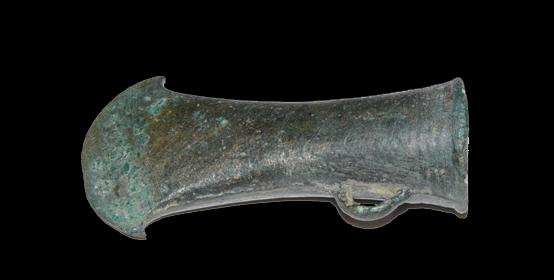
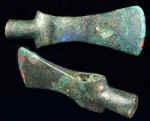
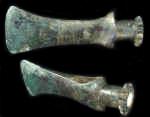
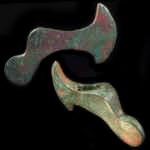
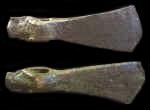
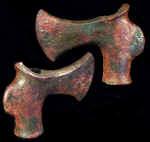

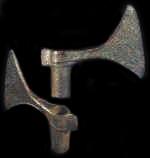
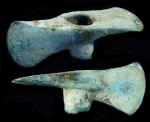
Designed by Nigel G Wilcox
Complimentary Topics
Copyright All Rights Reserved by Nigel G Wilcox E-Mail: ngwilcox100@gmail.com
The Paragon Of Metal Detecting
& Archaeology
& Archaeology
Tudor Jewellery - Pendants >>>
Pages
Main Coin Menu
Member NCMD
Specialised. Menu






















